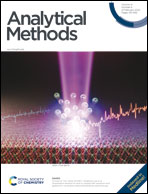A quinoline–benzothiazole-based chemosensor coupled with a smartphone for the rapid detection of In3+ ions†
Abstract
A newly designed quinoline–benzothiazole probe 2-((Z)-((E)-benzo[d]thiazol-2(3H)-ylidenehydrazono)methyl)quinolin-8-ol (L) was synthesized by reacting 8-hydroxyquinoline-2-carbaldehyde with 2-hydrazinobenzothiazole and structurally characterized by various spectroscopic techniques. The sensing ability of probe L was studied with various cations using colorimetry, test paper strips, a red–green–blue (RGB) model and UV-visible spectrophotometry in DMSO : H2O (3 : 7, v/v). The pale yellow colour of L turns into orange on contact with In3+ ions, whereas other tested metal ions did not show any change in colour. The probe L exhibits an absorbance band at 360 nm due to ligand-to-ligand charge transfer (LLCT); upon interaction with In3+ ions, it exhibits a band at 445 nm due to ligand-to-metal charge transfer (LMCT). The probe L binds In3+ in a 2 : 1 ratio with an association constant of 8.1 × 105 M−1 and this is established using the Job's and Benesi–Hildebrand (B–H) methods. The probe L can work in the pH range of 4–8 without interfering with other competing ions. It can be used to detect quantities as low as 2.3 ppb and 85 ppb by spectrophotometry and RGB, respectively. The binding mechanism was studied by 1H NMR titration, ESI mass and FT-IR spectral analysis and well supported by theoretical studies. Overall, probe L demonstrates promising potential for the detection of In3+ ions in the semi-aqueous phase and this is its first report as a colorimetric chromogenic probe.



 Please wait while we load your content...
Please wait while we load your content...